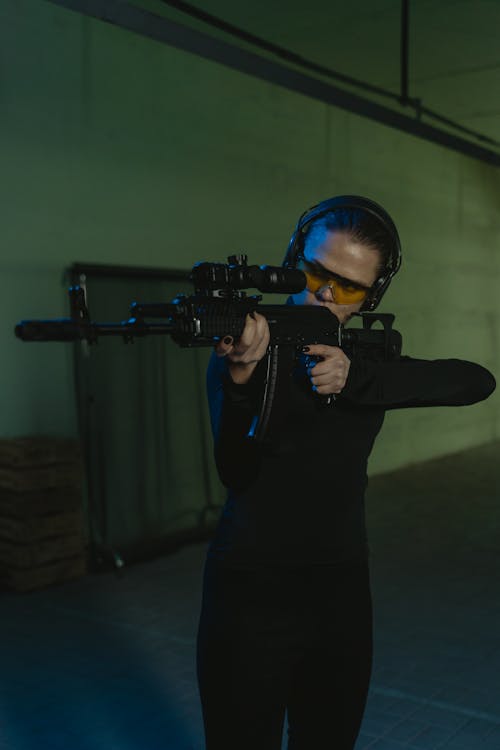Table of Contents
Finding that sweet spot on your rifle for your riflescope can be tricky.
It is part trial and error and part based on scope functions and features.
We are here to help you find that perfect spot on your rifle.
So, let’s get started!

How Far Back to Mount Scope?
How Far Back to Mount a Rifle Scope? My Expert Insights
Mounting riflescopes correctly is as much of an artistic process as it is a scientific process. Find the right place for your riflescope based on the distance you need to see and the type of scope you’re using. Your eyesight needs to be corrected if necessary.
Eye relief is very important. How you position your rifle for a shot is also important. You need to be aware of what you’re doing in the field. Your rifle needs to be positioned correctly for each shot.
Eye Relief – The Critical Distance
Eye relief is the distance from your eyes to the lenses of your rifle scopes. Most optical scope manufacturers list this information in their technical data sheets.
Why is Eye Relief So Critical?
Optical riflescopes usually have a range of distances at which your eye sees the best possible picture of the target. Mounting the scope correctly puts your eye in this critical distance. Your eye should be positioned at the right spot when you shoulder the gun. If your eye isn’t in the right place, several things could happen.
A dark ring or halo appears around the edges of the target image. This means that the scope is out of alignment on the rifle. Your rifle needs to be adjusted before you shoot again.
How Much is Enough?
Riflescopes are available in a wide variety of eye reliefs. You need to determine what length works best for your shooting style and your needs.
Short or Normal Eye Relief Lengths
Most optical riflescopes are short eye relief length. This means that the distance between your eyes and the lens is shorter than what you’d normally see with long eye relief scopes. Short eye relief scoped help you to see more of the target and also makes it easier to track moving targets.
Short eye relief scopes are usually mounted further back on the rifle than long eye relief scoped rifles. This allows you to hold your rifle more naturally when shooting. Your eyes are farther away from the barrel, so you see the target clearer.
Short eye relief scopes are great for hunters who want to be more stealthy. A hunter needs to know what he’s shooting at before firing, but if he doesn’t have enough time to get a clear shot, he should use a short eye relief scope to make sure he hits his target. Bigger calibers can cause problems with short eye relief.
Long Eye Relief Scopes
Some manufacturers do have longer eye-relief scopes available in their product line. These scopes typically feature an eye relief greater than four and a half inches. Longer eye-relief scopes are useful in some shooting scenarios such as hunting or target shooting.
A long eye relief scope allows you to mount your scope farther back on the action. This flexibility is useful when using a surplus bolt-action rifle.
Extra distance helps prevent shooter’s eyesight. Long eye relief scopes help improve accuracy. You should set up your rifle and riflescopes before starting out.
You need to bring the right tools and equipment to the range. You should expect to adjust your scope mount at the shooting range.
Benchresters should use a vise or a vice grip to hold their rifles steady. Hunters should adjust their riflescopes’ eye relief while sitting in a tree stand or other position.
Riflescopes should be mounted correctly. Mounting them improperly can damage the scope or make it perform poorly. Even inexpensive riflescopes will work fine if mounted properly.
What’s the Deal with Unlimited Eye Relief?
There are many types of optical devices that claim to offer unlimited eye relief. Some of them are digital rifle scopes, holographic sights, and reflex red dot sights. All of these devices rely on different technologies to provide the sight picture.
What Other Problems Can a Wrong Eye Relief Cause
You should always place your eye relief inside the scope when using a riflescope. This will prevent parallax distortion.
You should adjust the eye relief on your rifle scope. This means you need to change the distance between the front end of the scope and the rear end of the scope. Changing this distance will help you get a better sight picture when using your rifle scope.
Scope mounting should be done correctly to avoid missing shots. When adjusting your shooting position, do not move your head. Your rifle should stay still while you make adjustments.
Your favorite scope should be adjusted for the distance you want to shoot. You can adjust the eye relief by turning the adjustment knob.
Easy Steps on How to Mount Your Scope
Step 1: Gather Your Tools and Equipment
You’ll need a good set of tools to remove the scope rings from your rifle. Thread locker helps prevent rusting on the threads of the screws.
Step 2: Set Up Your Rifle the Way You Shoot
When hunting, you should use an adjustable cheek rest to raise and lower your rifle. You should also adjust the eye relief on your rifle scope.
Step 3: Adjust the Scope in the Rings
Loosen the rings on your scopes mount just enough to allow them to move back and forth. Bring your rifle up into a shooting position. Carefully slide the scope forward or backwards until you get the best image possible in the scope.
Note: If you want to know a complete guide about scopes click HERE.
Step 4: Tighten the Scope Rings
Carefully tighten the scope ring screw without moving the scope. Add a drop of blue thread locker to prevent the ring screws from loosening from recoil.
Step 5: Check your Scopes Image Across the Range of Magnification
With the scope ring screws properly torque, test the scope across the entire range of magnification. You may see slight changes in the image. If you are within the eye relief of the scope then there should be no change in the sight picture.
Don’t Set and Forget
Mounting your scope isn’t a set-and- forget operation. You must always check the eye relief position every time you zero your rifle. Accidents, recoil, and time can all cause changes to your scope position. Changing positions may also be affected by different eyeglass prescriptions or age.
Scope Eye Relief
Scope eye relief refers to how far away from the eyepiece the image appears to be. The closer the object appears to the viewer, the less distortion the lens has to correct for. This is measured in millimeters and is usually expressed as “eyepiece to target.”
Proper Eye Relief
The correct eye relief for riflescopes is 1/4 inch. This means that the distance between the front of the scope and the end of the eyepiece should be equal to one fourth of an inch. If the distance is less than one quarter of an inch, then the scope may cause blurred vision.
Range of Eye Relief
The range of eye relief in a rifle scope depends on the magnification power of the scope. A higher magnification means a longer eye relief. If you want to know how much eye relief you need for a particular magnification, you can use our free eye relief calculator.
A common low power rifle scope’s eye relief distance is 4 inches or 101.6 mm, which means that loss of image clarity will occur if one moves in closer or farther from it.
Scope Lens
Scope Lens is the part of the optical system that focuses light onto the reticle. The objective lens is the first element of the optical system. The objective lens has two functions:
- It collects light from the object, and
- It focuses the image onto the eyepiece.
When you find the right distance for the scope from your eye, crank up the magnification to ensure the positioning is good at maximum magnification.
Note: If you want to know What Color Loctite for Scope Mounting clicks HERE.
Screw Threads
Screw threads in riflescopes are used for attaching accessories such as magnifiers, red dots, and other devices. The screw thread is usually located at the rear end of the riflescope.
Scope Clearance
Scope clearance refers to the distance between the objective lens of a rifle scope and the eye of the shooter. The higher the number, the closer the eye must be from the objective lens for the image to appear sharp. A typical range is 30 inches to 60 inches.
Scope Bell
Scope Bell is a feature found in some riflescope models that allows you to adjust the magnification level of the scope. This feature is useful for hunting and target shooting. The best way to use this feature is to hold down the button until the desired magnification level appears.
Note: If you want to gain information about Where to Buy Vortex Scopes click HERE.
Dot Scopes
Dot Scope is a feature found on some scopes that allows you to magnify the image at certain distances. This is useful for hunting because it helps you find animals at longer distances.
Depth of Field
Depth of field refers to how much of the subject appears sharp in the image. The greater the DOF, the sharper the image. A rifle scope has a fixed focal length, which means that the magnification ratio stays constant regardless of distance from the target. This makes the rifle scope ideal for shooting at long distances. However, when shooting close up, the magnification becomes too high for comfortable viewing. To solve this problem, rifle scopes come equipped with variable power zoom lenses. These lenses allow the shooter to change the magnification while keeping the same focal length. This allows the shooter to choose between a wide-angle view for long-range shots and a telephoto view for close-up work.
Base Ring Setup
Base Ring Setup is a term used for the distance between the objective lens and the eye piece. The closer the objective lens is to the eyepiece, the better the magnification power. This is why the higher the magnification power, the longer the focal length of the scope. A typical rifle scope has a magnification range from 10x to 50x.
Note; If you want to know Where are Swarovski Scopes Made click HERE.
Conclusion and Things to Remember…
Above explained is the most basic and common setup you see on hunting rifles.
You should mount your scope at least 30 inches from the eyepiece. This will allow you to see more clearly and it also makes it easier for you to hold the rifle steady when shooting. Not many of us are competitive target shooters who can have a steady bench rest from which to shoot.
Always apply blue Loctite to the base screws if you like, and torque the screws using the manufacturer’s specifications with your torque wrench.
If you want to know more information about scopes click HERE.
Author
-

John is the Editor in Chief here at The Outdoor Stores. His area of expertise ensures that there is no one better to suggest which rifles are most suitable for your hunting experience. He is also available for you to contact him personally to discuss the types of animals you want to hunt and the terrain you will be hunting on.
Feel free to read his posts for expert opinion on Rifles, Scopes, Rangefinders, Bonoculars and Monoculars.
View all posts






